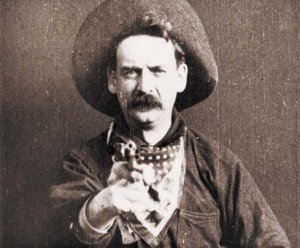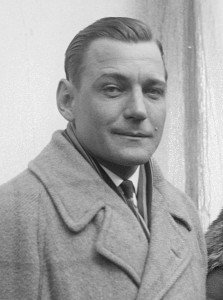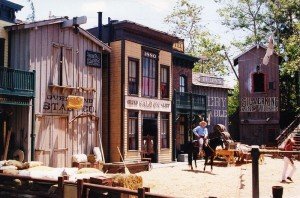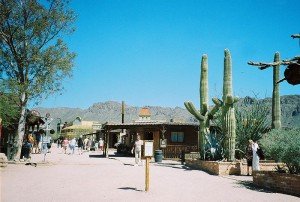Over the years of movie making, the old western movie genre came and went and then came again. The fact is that when the movie industry first began during the very early years of the 20th century, the western was king. Everyone wanted to make western movies and many did.
Thank you for reading this post, don't forget to subscribe!The Early Western Movies
The earliest well known old western movie produced was The Great Train Robbery. The Great Train Robbery was filmed in 1903. It was also filmed in Milltown New Jersey. This was the time that the east coast was the headquarters for the growing movie making industry.

Actors included Broncho Billy Anderson, Justus D. Barnes and Alfred C. Abadie. As the industry of western movies began originating out of Hollywood California, the plots and sets grew. Location shooting was the order of the day. Old western towns were hastily put up on location. Thankfully for the producers of old westerns, the Los Angeles area in the early and mid 1900’s proved to be advantageous for shooting western films. At the beginning, most settings were very near to Los Angeles. Perhaps a few hours drive. This was before the population exploded and land values went up with them.
Where to Find All Those Extras?
It just so happened that at the time the old western movie craze took off, the ranching industry was in general decline. The open spaces were being fenced in at a fast rate and the population growth was moving westward. Unfortunately, for the real live cowboy who had spent his days working the range, he now might have found himself out of a job. There were not a great many occupations that you could segue into, aside from the rodeo, with the talents of knowing how to ride a fast horse, knowing how to rope a steer or even how to handle firearms. What some people might term progress was not a good omen for the professional cowboy.
As western movie production became more elaborate and with some scenes requiring the presence of many horsemen, the old cowboy found another calling. Think back to those westerns featuring a galloping cavalry, a band of Indians on horseback or a fast riding sheriff’s posse. All of those scenes required people with horsemanship skills. This time represented the birth of the western movie stuntman.

All of those scenes needed people who not only looked like genuine cowboys, but actually were. The western movie producers turned to a ready supply of talented riders, actual cowboys looking for work in Hollywood.
The Local Los Angeles Watering Hole
With a good many cowboys finding themselves out of a job, the lure of Hollywood didn’t sound so bad. It wasn’t the same thing as being a real cowboy, but taking part in movies and being paid for it wasn’t such a bad thing either. It was about as close as a real cowboy could get to being a cowboy. Making a job out of it appealed to many. The timing was good. Being a paid movie stuntman sounded pretty good.
The way it worked in Hollywood went like this. According to the book , Wild West Show, edited by Thomas W. Knowles and Joe R. Lansdale, the ex-cowboys would congregate at a Los Angeles speakeasy that was called the Waterhole. The cowboys would gather there and wait to hear from the movie studios. In that era, one never knew when a director would send an assistant over to the Waterhole for extras. These jobs were referred to as “riding extras“. Maybe the director needed riders for a cavalry shoot or for a band of Indians on horseback. If this was the case, then there was work. While it was work, nobody claimed to have become rich doing it. The pay was generally $10 per day plus a box lunch. The cowboys who were hired, and this was usually on a day to day basis, would show up the next morning bright and early at the studio wearing their cowboy clothes. For this pay, the riding extras would ride all over movie sets spread around Los Angeles, many to the north in the vicinity of the San Fernando Valley. Many locations where the old westerns were filmed are now covered by subdivisions.

Some cowboy riding extras and movie stuntmen had their own horses which were usually kept at a Los Angeles corral called the Sunset Corral. The next time you have a chance to watch one of these very early westerns, you’ll know where that large cavalry regiment came from… the Waterhole.
These western cowboy riding extras also knew how to fall off a horse if need be without killing themselves. This type of individual was in great demand. The old cowboys also knew how to rope. These were things that generally weren’t the strong suit of leading men actors. The most noted exception was Tom Mix who knew how to wrangle cattle. Mix knew how to rope and ride. Tom Mix made some 160 cowboy matinee movies during the 1920’s alone and is thought of by many as being the first matinee cowboy idol. Mix had previously worked in Oklahoma at the very large Miller Brothers 101 Ranch. He knew how to ride a fast horse, rope as good as anyone and was said to be pretty good with a six-shooter. Mix won the 1909 National Riding and Rodeo Championship. Not bad skills for a Hollywood actor during the days of the western.
Who Were the Cowboy Stuntmen?
There were obviously many cowboys who worked as western movie riding extras. Some names however stand out. Some became more than just movie extras. These include Hank Bell, Jack Montgomery, Bill Gillis and Jack Padjeon, just to name a few.
Padjeon was in many old western films during the 1920’s and 30’s. He turns up as early as 1923 as a stunt rider in the western film, Covered Wagon. Padjeon also played Wild Bill Hickok in The Iron Horse, directed by John Ford in 1924.
Hank Bell appeared in well over 300 films, mostly westerns, between 1920 and 1952. Some of Bell’s movies included The White Horseman in 1921, The Oregon Trail in 1923 and Tall in the Saddle in 1944.
Jack Montgomery got into the old western movie business when some of his ranch cowboys told him they were leaving and heading for Hollywood. It appears that Jack Montgomery decided to also. He worked for a time as a stand in and stuntman for Tom Mix. Actually, Mix preferred to do his own stunts but the director would urge him to use a stuntman because if he was injured it could hold up production for an indefinite time. Mix didn’t quite see it that way but finally agreed to the directors wishes. Regardless, Tom Mix made it a point not to publicize the fact that he used doubles. Maybe he thought it was bad for the rough and tumble cowboy image. Mix wanted to protect his image and the studio wanted to protect it’s investment. Some of Jack Montgomery’s films aside for doubling in Tom Mix movies included Courage of the West produced in 1937, The Dark Command made in 1940 and starred Walter Pidgeon and The Renegade in 1943 which featured Buster Crabbe.

Bill Gillis enjoyed a good career playing mostly villains in old westerns of the 1920s. Other Gillis films included a role as a cowhand in Sunset Range made in 1935 and starring Hoot Gibson. He worked in the 1940 Gary Cooper movie The Westerner. He also had a minor acting role in Winchester ’73 produced in 1950.
There of course were many more rider extras and stuntmen than are listed here, and who in some cases received acting credit during the heyday of the western motion picture. These early Hollywood cowboys highlighted above were part of what was known as The Gower Gulch Gang. They took this name simply because many of the small studios cranking out the westerns were located on Gower Avenue in Los Angeles. The Gower Gulch Gang in many cases helped make their living by playing roles in movies which often times portrayed exactly who they had been all along. It was a great way to earn money while the work lasted. If it wasn’t for the Gower Gulch Gang, we might not have been able to enjoy those dramatic scenes of cavalry and Indian fighters racing on horseback across the plains and desert.

Two additional articles you’ll find interesting are Cattle Drives and Cowboys / What it Was Really Like and our story about Pawnee Bill and his Wild West Show.
Today, a terrific old western movie studio that receives many thousands of visitors annually is the Old Tucson Studios just a few miles west of Tucson Arizona. The Old Tucson Studios is both a theme park and movie location which is still being used today for both Hollywood and television productions.
(Old Tucson Studios photo courtesy of James G. Howes. All other photos are in the public domain)
